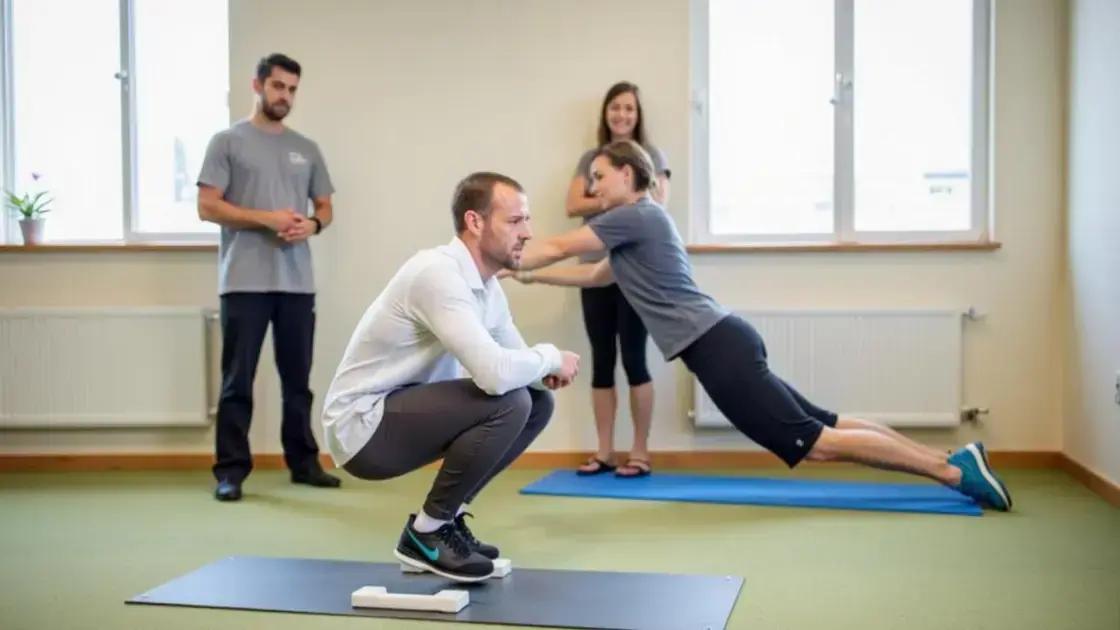Rebuilding strength after an injury involves understanding the recovery process, engaging in appropriate exercises, maintaining a balanced diet for nutrition, and setting realistic goals. By following these guidelines, you can effectively regain strength and return to your regular activities.
Rebuilding strength after an injury can feel daunting, but with the right approach, it is achievable. When you sustain an injury, your body needs time and proper care to heal. This article will discuss effective strategies and exercises to help you recover your strength, making sure to prioritize nutrition and realistic goal setting to facilitate a smoother rehabilitation process. Let’s dive into the steps necessary for getting back on track!
Understanding Strength Recovery

Understanding strength recovery involves recognizing how your body mends and regains functionality after an injury. It is important to realize that recovery is a gradual process. Everyone heals at different rates, influenced by factors such as age, severity of the injury, and overall health. Here, we will explore how to support your body during this phase.
Phases of Recovery
The recovery process is typically divided into three phases: inflammation, repair, and remodeling. During the inflammation phase, which lasts a few days, your body responds to injury by swelling and producing pain to protect the affected area. The repair phase begins shortly after, lasting from several days to weeks, when the body starts to mend damaged tissues. Finally, the remodeling phase can last for months, as the new tissue strengthens and adapts to stress.
Importance of Patience
It is crucial to approach strength recovery with patience. Rushing back into physical activity can lead to setbacks and extended healing times. It is natural to want to return to your previous fitness level, but allowing your body appropriate time to heal is critical. Focus on small, achievable goals rather than jumping back into your old routine.
Listen to Your Body
Throughout your recovery, pay close attention to your body’s signals. Pain is a clear indication that something may not be right. If you experience pain during certain exercises, it is important to stop and reassess your movements. Ideally, work with a physical therapist who can provide guidance and ensure that you’re performing exercises correctly.
Gradual Progression
Once you feel ready, start introducing low-impact activities that promote strength and flexibility, such as swimming or cycling. Gradually increase the intensity and duration of these exercises as you regain strength. Aim for a balanced approach that mixes strength training, cardiovascular fitness, and flexibility work for optimal recovery.
In summary, understanding the process of strength recovery is essential for a successful rehabilitation journey. With time, patience, and attentive care, you can regain your strength and return to the activities you love.
Key Exercises to Rebuild Strength

Key exercises to rebuild strength focus on gradually enhancing your body’s stability, flexibility, and muscle function after an injury. It is essential to start with low-impact workouts and progressively increase intensity. Here are some effective exercises that can help you regain strength:
1. Bodyweight Squats
Bodyweight squats help to strengthen your legs and core without placing too much stress on your joints. Stand with your feet shoulder-width apart, lower your body as if sitting back into a chair, and keep your chest up. Aim for two sets of 10-15 repetitions.
2. Modified Push-Ups
Modified push-ups allow you to work on upper body strength while reducing strain. You can perform them on your knees. Keep your hands slightly wider than shoulder-width, lower your body towards the floor, and push back up. Consider two sets of 8-12 repetitions.
3. Bridges
Bridges target your glutes and lower back, promoting stability. Lie on your back, bend your knees, and keep your feet flat on the floor. Raise your hips towards the ceiling, squeezing your glutes at the top. Try to do three sets of 10-15 repetitions.
4. Seated Rows
Using bands or resistance machines for seated rows can help strengthen your back. Sit upright with your knees slightly bent, grasp the band, and pull it towards your chest while keeping your elbows close to your body. Perform two sets of 10-12 repetitions.
5. Standing Calf Raises
Calf raises strengthen your lower legs and improve balance. Stand straight, slowly raise your heels off the ground, balancing on the balls of your feet, and then lower back down. Aim for three sets of 15 repetitions.
It is important to perform these exercises with proper form to avoid injury. Also, consider consulting with a physical therapist or a trainer who can provide personalized guidance tailored to your situation.
The Role of Nutrition in Recovery

The role of nutrition in recovery is vital when rebuilding strength after an injury. Your body needs the right nutrients to heal properly and regain strength. A balanced diet can promote recovery, reduce inflammation, and rebuild muscle tissue.
Protein for Muscle Repair
Including enough protein in your diet is crucial. Protein helps your body repair damaged tissues and regenerate muscle. Aim for protein-rich foods like chicken, fish, beans, and nuts. Consider having protein during meals and snacks to support muscle growth.
Healthy Fats for Inflammation
Incorporating healthy fats can aid in reducing inflammation. Foods like avocados, olive oil, and fatty fish, such as salmon, are excellent choices. Omega-3 fatty acids found in these foods can help support joint health and speed up recovery.
Carbohydrates for Energy
Don’t forget carbohydrates in your diet! Carbs are the body’s main source of energy. Whole grains, fruits, and vegetables provide the fuel you need to stay active and perform physical therapy exercises effectively.
Hydration Matters
Staying hydrated is equally important during recovery. Water aids in digestion, nutrient transportation, and joint lubrication. Aim for 8 glasses of water a day, and increase this if you are sweating or exercising more.
Vitamins and Minerals
Essential vitamins and minerals play a big role in healing as well. Vitamin C helps with collagen formation, which is vital for tissue repair. Sources of vitamin C include citrus fruits, strawberries, and leafy greens. Additionally, ensure you get enough calcium and vitamin D for bone health, particularly if you are recovering from bone-related injuries.
By focusing on your nutrition, you can significantly impact your recovery process, helping your body heal and regain strength more efficiently.
Setting Realistic Goals for Rehabilitation

Setting realistic goals for rehabilitation is key to recovering strength after an injury. Goals help you stay focused and motivated, making it easier to track your progress. Here are some tips on how to set achievable goals:
1. Start Small
When recovering from an injury, it’s important to begin with small, specific goals. For example, you might aim to complete a certain number of exercise repetitions or walk a particular distance each day. Starting small allows you to build confidence and keep your spirits high.
2. Make Goals Measurable
Your goals should be measurable. This means you should be able to track your progress. Instead of saying, “I want to get stronger,” set a specific target, like “I will increase my bodyweight squats by five repetitions this week.” This clarity keeps you accountable.
3. Be Realistic
Evaluate your current abilities and set goals that match your situation. If your injury is still healing, it may not be the right time for high-intensity workouts. Understand your limits, and if needed, consult with a therapist to set appropriate targets.
4. Adjust as Needed
Be open to adjusting your goals based on how your recovery progresses. If you are feeling great and hitting targets faster than expected, don’t hesitate to set new goals. Conversely, if you’re facing setbacks, make sure your goals remain realistic.
5. Celebrate Achievements
Recognize and celebrate your achievements along the way. Whether it’s reaching a milestone or consistently sticking to your routine, rewarding yourself can boost your motivation. Consider small treats or non-food rewards that will make you feel accomplished.
By focusing on setting achievable goals, you not only guide your recovery process but also maintain a positive mindset that is essential to rebuilding strength.
Rebuilding Strength: Your Path to Recovery
Recovering strength after an injury is a journey that requires patience, dedication, and a structured approach. By understanding the recovery process, incorporating key exercises, focusing on nutrition, and setting realistic goals, you can effectively navigate this path.
Remember to listen to your body and make adjustments as needed. Celebrate your milestones, no matter how small, and stay motivated throughout your rehabilitation.
With the right mindset and a commitment to your recovery plan, you will regain your strength and return to the activities you love with confidence.
FAQ – Frequently Asked Questions About Rebuilding Strength After an Injury
What are the first steps I should take after an injury?
Initially, focus on rest and follow your doctor’s advice. Gradually introduce light activities to promote healing without overexerting yourself.
How important is nutrition in recovery?
Nutrition plays a crucial role in recovery. A balanced diet rich in protein, healthy fats, and carbohydrates helps your body heal and regain strength.
What types of exercises should I do to rebuild strength?
Start with bodyweight exercises such as squats and modified push-ups. Gradually progress with resistance training as you gain strength.
How do I know if I’m setting realistic rehabilitation goals?
Evaluate your current abilities and consider your injury’s severity. Setting small, measurable goals helps ensure they are achievable.
Why is it important to listen to my body during recovery?
Listening to your body helps you avoid setbacks. If you feel pain or discomfort during exercises, it’s essential to stop and reassess your routine.
Can I recover strength without professional guidance?
While you can make progress on your own, consulting a physical therapist or trainer can provide personalized guidance and ensure proper technique.












